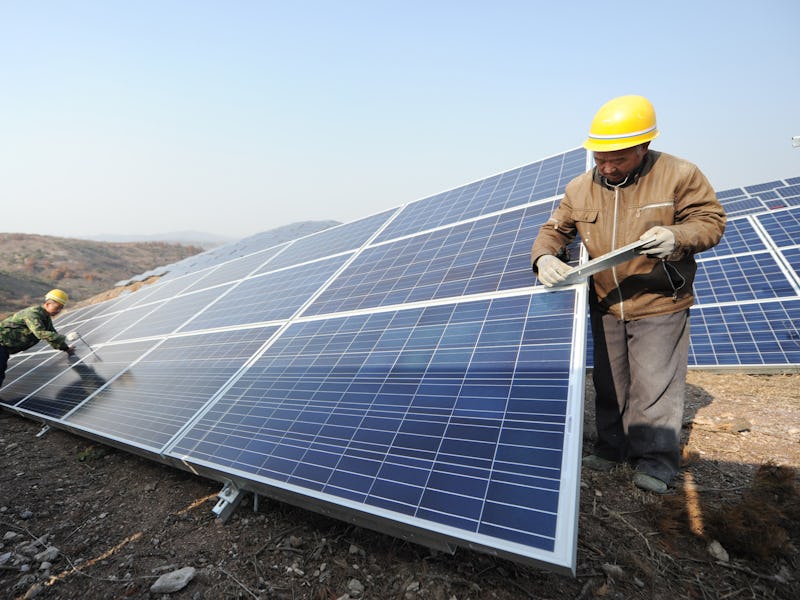People are Rushing to Install Solar Panels in Hurricane-Hit Areas
EnergySage has seen a big spike in interest.

Residents in hurricane-affected areas are rushing to research renewables, a major solar energy comparison site tells Inverse. EnergySage, which enables consumers to compare prices from a number of suppliers, reports a spike in interest from Texas, Louisiana, and Florida following the recent hurricanes.
“Our website traffic from these states have increased dramatically,” says Vikram Aggarwal, CEO of EnergySage. “We thought these people would be reeling from the damage and traffic would actually slow down.”
The jump is part of a growing interest in solar, as communities seek to rebuild after a series of hurricanes over the past few months. Beyond the mainland United States, companies are jumping to install solar in Puerto Rico to get the power back online, while advocates point to the resilience of installations on the Turks and Caicos islands as a sign that solar could help.
EnergySage, which has over a million annual shoppers from 35 states, compared stats from three markets: Texas, Louisiana, and Florida. These three have been hit by a number of hurricanes over the past two months, with Harvey hitting Texas and Louisiana in August, Irma hitting Florida in September, and Nate in Louisiana this month.
Rain from Hurricane Harvey batters the downtown area on August 26, 2017 in Houston, Texas.
The results were staggering. In the past two months, site traffic from Florida was up 57 percent compared to the two months prior, while Louisiana was up 16.4 percent over the same period. Site registrations over that period, which allows users to compare quotes, increased 64 percent from Florida and 57 percent in Louisiana.
“We’ve spoken to a couple of folks in these areas, and they’re realizing the grid needs some help,” Aggarwal says. “Our grid is old, it’s the hub-and-spoke structure, and it may be time to think about more distributed generation and storage.”
One section of the site received particular attention. A blog post, entitled “Can solar panels withstand hail and survive hurricanes?” saw a massive spike in traffic, with a 1,230 percent increase in overall visitors. When broken down by state, Louisiana saw a 925 percent increase, and Texas a 692 percent increase. Florida, though, saw an incredible 2,935 percent more visitors to the page.
Kindrell Hutchinson washes off a solar panel system at the Leveda Brown Environmental Park and Transfer Station on April 16, 2009 in Gainesville, Florida.
A key benefit of solar is its decentralized approach. Batteries can store up solar energy during sunny days, providing power to local areas with less dependence on a giant grid system. In the wake of the hurricanes, the nonprofit Rocky Mountain Institute claimed that solar installations on the Turks and Caicos islands remained functional even as the power utility claimed over 1,200 poles were down.
“A lot of the solar companies are taking this as an opportunity to create buzz for solar and storage solutions,” Aggarwal says. “A little bit opportunistic for the industry to do that, but they have customers who are now willing to listen.”
Companies are recognizing this attention and taking action, particularly in Puerto Rico. Tesla CEO Elon Musk spoke with governor Ricardo Rossello about using the company’s technology to develop a “flagship project” and restore power:
CNBC reported on Monday that solar companies like Vivint Solar and Sunrun are expected to bring about $2 million worth of supplies over the coming weeks.
Some fear that this rush could have consequences. Kate Aronoff, a writer for In These Times, noted the state-owned Puerto Rico Electric Power Authority could find itself beholden to new forces depending on the deals struck between the government and suppliers.
“For now, PREPA carries a similar mandate to serve the public as a public corporation, though privatization could change that,” Aronoff said. “If its operations are broken up and sold off—as one proposal outlined—different pieces of PREPA (or the utility formerly known as PREPA) could be accountable to different sets of shareholders.”
Streets in the Guaynabo suburb are flooded after Hurricane Maria made landfall, September 21, 2017 in San Juan, Puerto Rico.
It’s not just solar firms looking to make a quick buck that are taking notice, though. One crowdfunded organization, Light Up Puerto Rico, was set up in the days after the storm. Jorge and Carilu Alvarado, the two Puerto Ricans behind the project, are working with the Tifie Humanitarian charity to bring $700,000 worth of supplies by the end of the week.
In the wake of the hurricanes, people want solutions. The pressure is mounting for a large-scale switch.
“Local and state leaders need to push for the Sunshine State to get more juice from its namesake,” reporter Andy Reid said in Florida’s Sun Sentinel.